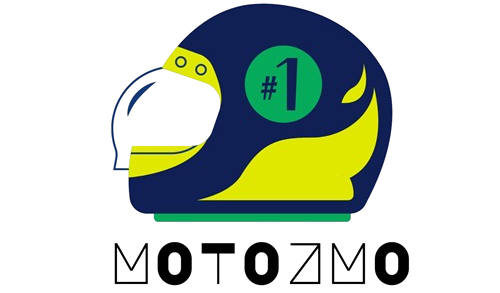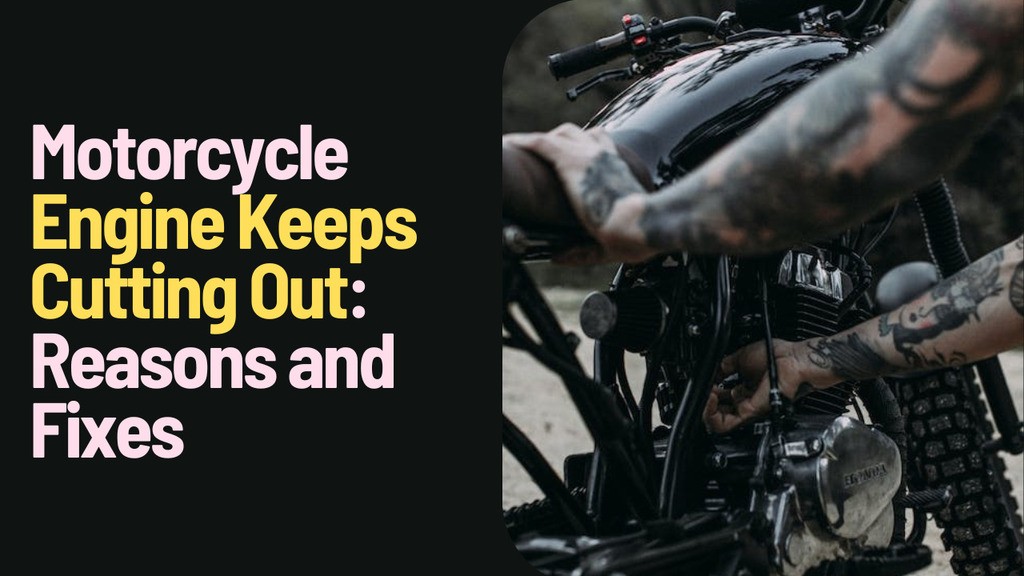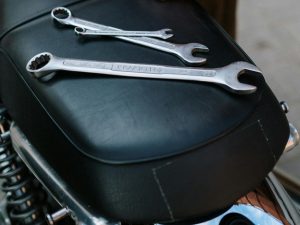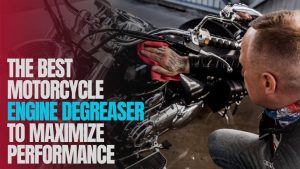🎯 Key Takeaways
- Fuel problems are the most common cause of engine cut-outs. Check for low fuel, clogged filters, contaminated gas, or a faulty fuel pump or cap vent.
- Ignition and electrical faults can interrupt spark delivery. Worn spark plugs, cracked wires, weak batteries, or faulty sensors and connections can all shut the engine off suddenly.
- Air intake issues like a dirty air filter or vacuum leaks disturb the air/fuel mix. This can cause stalling, rough idle, or hesitation under load.
- Overheating and blocked exhausts create backpressure or trigger safety shut-offs. Always monitor coolant levels, radiator function, and oil condition.
- Mechanical faults, such as worn timing chains, low compression, or clutch problems, can cause stalling, especially under load or when slowing down.
It’s both annoying and worrying when you’re riding and your motorcycle engine keeps cutting out. You’re cruising along, then suddenly… nothing. This guide digs into why that happens and what to do about it, step by simple step.
Possible Causes of Motorcycle Engine Keeps Cutting Out
One thing we’ve learned from our years wrenching on bikes is there’s usually a reason these cut-outs occur.
Nothing frustrates riders more than a bike that was fine one minute and dead the next with no explanation.
Now let’s dive into some potential causes so you’ve got an idea where to start looking when the bike starts acting up.
1. Fuel Supply Issues
Fuel problems are the most common reason your motorcycle engine might cut out. Here are the usual suspects, explained simply:
a) Low Fuel or Empty Tank
Sometimes you just run out of fuel or the gauge tricks you. One moment you’re riding, the next, your bike goes dead. It’s simple, but easy to miss.
b) Clogged Fuel Line or Filter
Dirt, old fuel, or debris can clog your fuel filter or line. Even with a full tank, the engine starves. Riders often report that if you look at the filter or line, it’s full of gunk instead of gasoline, and that’s your clue.
c) Water or Contaminated Fuel
Water or other trash sneaks into your fuel. That gum-up slows or blocks fuel flow. Watch for black goo near the filter or pump.
d) Faulty Fuel Pump or Regulator
Pumps wear out. They may work fine when the engine is cool, but sputter or die when things heat up. Without steady pressure, the engine can’t run right.
e) Clogged Fuel Cap Vent
If the fuel cap vent gets blocked, air can’t get in the tank. That builds a vacuum. Fuel can’t flow, and your engine cuts out mid-ride. It’s even more common if the bike’s been in storage.
Replace clogged filters or cracked fuel lines.
If the bike sputters when hot, test the pump or pressure.
Pop the fuel cap to check for venting, listen for a little hiss. Clean or replace the cap if needed.
2. Ignition and Electrical Glitches
If your engine isn’t getting spark or clean power, it can die instantly.
a) Worn Spark Plugs, Wires, Coil, or Switch
Old plugs stop sparking. Ignition wires crack from heat. Coils or switches wear out, they all can interrupt combustion unannounced.
b) Weak or Dead Battery
If the battery is dying, it can’t support spark or fuel injection systems. Lights may flicker or go dim before the engine quits.
c) Loose Connections or Corrosion
Vibration shakes connectors loose. Rust or dirt around wiring adds to the problem. That flaky connection can cut spark or fuel delivery at any time.
d) Sensors, CDI, or ECU Failures
Modern bikes rely on smart sensors and electric brains. If sensors lie about speed or throttle position, or if the CDI or ECU fails, the engine can stall with no warning.
Check battery voltage, 12.6 V is good.
Tighten and clean wiring. Use dielectric grease to protect connections.
If you can, scan for fault codes or replace suspect sensors or units.
3. Air Flow and Intake Problems
Your bike needs clean, steady air. Blocked or leaky intake systems disrupt the balance and can stall the engine.
a) Clogged Air Filter
Dirt blocks airflow. Your engine chokes and sputters under load. You may feel lazy acceleration or odd idle behavior.
b) Vacuum or Intake Leaks
Cracked hoses or loose clamps let in unmeasured air. That spoils the air/fuel mix and makes the engine stall or run rough.
c) Throttle Body Synchronization (for multi-cylinder bikes)
If your bike has more than one throttle body, they must breathe together. If one lags, the engine won’t run smoothly and may stall.
Replace cracked intake hoses and tighten clamps.
Sync your throttle bodies when performing service or tuning.
4. Cooling, Overheating & Exhaust Backpressure
Heat and blocked exhaust can shut your engine down like a safety switch.
a) Overheating
Low coolant, a blocked radiator, broken fan, or old oil can make the engine overheat. Many bikes will shut off automatically to protect the motor.
b) Blocked Exhaust or Backpressure
If the muffler or catalytic converter is jammed up, exhaust flow backs up. That pressure overheats the engine or slows it to a stall.
Check that the radiator and fan work properly.
Clean any debris or blockage from the exhaust system.
4. Mechanical and Engine-Timing Faults
When the engine’s timing or mechanics go off-beat, your bike misfires or shut downs, especially when shifting or clutching.
a) Worn Timing Chain or Belt
When timing gets off, valves open at the wrong time. The engine just stops mid-ride, sometimes suddenly.
b) Low Compression or Worn Valves
Worn rings, gaskets, or unadjusted valves kill compression. That makes starting hard, and idle shaky or dead.
c) Internal Engine Damage
Broken valves, crank issues, or seized parts detonate or lock the engine instantly, it’s rare, but terrifying when it happens.
d) Clutch or Gearbox Issues
A slipping clutch or sloppy gear shift can stall the bike, especially when slowing or pulling the clutch in.
Do a compression test and adjust valves.
Replace worn clutch parts or smooth out gearbox problems.
Listen for strange noises or heat that indicate internal trouble.
Diagnosis: Tracking Down Bike’s Intermittent Cut-Outs Issues
When your motorcycle engine keeps cutting out, guessing randomly wastes time, and can cost money. A smart, step-by-step approach helps you find the real problem faster.
Step 1: Pay Attention to When It Happens
Before grabbing any tools, think about what was happening when the engine died. Ask yourself:
- Did it cut out right after filling up?
- Was the engine hot when it stalled?
- Did it happen in the rain or after washing the bike?
- Does it stall only when idling or during acceleration?
Write down the symptoms. Noting these details can point you toward the problem area.
Step 2: Start with the Fuel System
Fuel is often the easiest to check. Do this first:
- Tap the gas cap. A quiet “whoosh” means the vent is working. If there’s no sound, the vent might be blocked.
- Check the fuel level. It’s simple, but don’t overlook it.
- Inspect the fuel filter. If it’s dirty or full of gunk, replace it.
- Squeeze the fuel lines. They should feel firm, not brittle or soft.
- Check the pump. If your bike has one, listen for the pump priming when you turn the key.
If anything in the fuel system looks bad, fix it before moving on.
Step 3: Test for Spark
Without spark, your engine won’t run, no matter how much fuel you’ve got.
- Remove a spark plug and leave the wire attached.
- Hold the metal part of the plug against the engine (or use a spark tester).
- Crank the engine and look for a strong, blue spark.
No spark? You could have bad plugs, wires, a coil problem, or a dying battery.
Step 4: Check Air Flow and Intake
The engine needs clean air to mix with fuel.
- Inspect the air filter. Dirty or soaked filters choke your engine.
- Smell around the intake boots. A strong fuel smell might mean a vacuum leak.
- Spray a bit of carb cleaner (or soapy water) near the intake while the engine runs; if RPMs change, there’s a leak.
Leaks are more common than you think, especially on older bikes or after rough rides.
Step 5: Rule Out Electrical and Sensors
Now look at wires and electronics:
- Turn the key and watch the dash. Do warning lights flicker or stay off?
- Wiggle wires gently. If the bike stalls or the lights flicker, you’ve found a bad connection.
- Look for corrosion on plugs or terminals.
- If your bike has a diagnostic port, scan for trouble codes using an OBD tool or dealer tool.
These steps can catch things like a faulty ignition switch, crank sensor, or ECU issue.
Step 6: Monitor Heat and Cooling
Overheating engines shut themselves off to prevent damage.
- Watch the temperature gauge or light while riding.
- Check coolant level when the engine is cold; top it off if it’s low.
- Make sure the radiator fan kicks on when things get hot.
- Don’t forget to check oil condition and level. Old or thin oil won’t protect the engine as well.
Step 7: Mechanical Checks (Last Step)
If all else seems okay, it’s time to dig deeper.
- Do a compression test. This tells you if your engine is holding pressure.
- Check valve clearance. If valves are too tight or loose, your engine may misfire or stall.
- Listen for knocking or ticking sounds. These might signal deeper mechanical wear.
Only move to this step if fuel, spark, air, electrical, and cooling systems check out.
How to Keep Your Bike Run Smooth with Routine Care
Preventing problems is way easier than fixing them. A few quick checks each weekend (or at least monthly) can save you from annoying breakdowns.
Here’s a simple checklist to keep your bike happy:
Fuel & Fuel System
- Check the fuel level before every ride
- Make sure the fuel cap vent isn’t clogged
- Inspect your fuel filter for dirt or discoloration
- Look for cracks or leaks in the fuel lines
Battery & Electrical
- Use a voltmeter to check the battery (12.6 volts or higher = healthy)
- Tug lightly on the cables to ensure tight connections
- Look for corrosion around terminals and clean if needed
- Watch for flickering dash lights or headlights, they can warn of trouble early
Air & Spark
- Clean or replace the air filter regularly
- Pull spark plugs to inspect them, black and sooty means they’re not firing right
- Replace old plugs or wires every few seasons
Cooling & Oil
- Check coolant level when the engine is cold
- Look inside the radiator cap for clean, bright coolant (not rusty or oily)
- Top off engine oil or change it according to your manual
- Listen for fan operation when the engine gets warm
Other Red Flags to Watch
- Warning lights that flash or stay on
- Weird sounds like ticking, clunking, or whining
- Sticky shifting or slipping clutch feel
- Unusual smells from fuel, coolant, or oil
These small checkups take 10–15 minutes, tops, but they keep your bike reliable, safe, and smooth on the road.
The Final Words
Many things can cause your motorcycle’s engine to cut out. But most fixes begin with simple, clear steps. Start with fuel, spark, air, then go deeper if needed. Take time each ride to check your bike. Fixing small problems early keeps you cruising with confidence.
FAQs About Motorcycle Engine Keeps Cutting Out
Why does my motorcycle cut out only when it’s hot or warm?
Can a blocked fuel cap vent cause my bike to stall?
Yes. If the fuel cap vent is blocked, a vacuum builds in the tank and stops fuel flow, causing shutdowns during riding.






![Read more about the article How to Measure Motorcycle Handlebar Diameter [For the Perfect Fit]](https://www.motozmo.com/wp-content/uploads/2023/11/motorcycle-handlebar-300x169.jpg)
